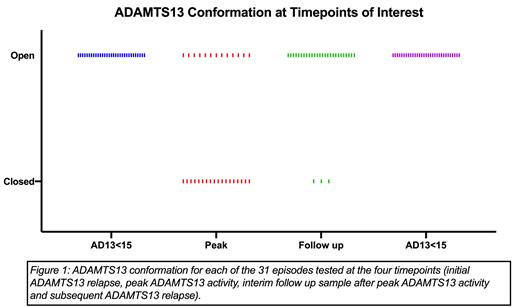Introduction
The use of rituximab to prevent clinical TTP relapse is widely accepted practice. However, the optimal dosing and regimen remains unclear with a variety used across treating centres. ‘Standard’ dosing is extrapolated from dosing for lymphoproliferative diseases: an equally efficacious lower dose would be time & cost-saving. We are investigating the impact of low dose (4 x 200mg weekly) vs standard dose rituximab (4 x 375mg/m 2 weekly) on ADAMTS13 response utilising prospectively collected samples from 69 ADAMTS13 relapse episodes from 4 UK sites who received elective treatment between 2017-2022 (REC: 17/LO/1055).
A subset analysis of the cohort was performed, investigating open/closed ADAMTS13 conformation from time of elective rituximab treatment to subsequent rituximab retreatment.
Method
ADAMTS13 activity was measured at fixed timepoints from first day of elective rituximab on days 1, 8, 15 & 22, month 1, 3, 6 and then 6 monthly until retreatment. Open/closed ADAMTS13 conformation was analysed in a subset of 31 episodes with the 1C4 ELISA and ADAMTS13 antigen ELISA at 4 different timepoints (ADAMTS13 activity <15IU/dL or %; peak ADAMTS13 activity; interim follow-up sample after peak ADAMTS13 and at next ADAMTS13 relapse).
Results
Median time from one elective rituximab treatment to the next was 16 months (range: 2 - 64, IQR: 9 - 24) for the subset. Time to ADAMTS13 activity normalization was compared in 26 episodes: 5 episodes were excluded as they failed to achieve ADAMTS13 normalization. 17/31 had low dose and 14/31 standard dose. There was no significant difference in the rate of ADAMTS13 normalization in the low dose compared to standard dose rituximab regime, with median 34 days ( IQR: 18 - 99, range: 14 - 266) and 21 days (IQR: 15 - 65, range: 14 - 94) respectively.
13 patients remained in an open ADAMTS13 conformation at all four timepoints, of which 9 had received low dose rituximab. 5 of 13 patients did not achieve a normal ADAMTS13 activity (i.e. >60IU/dL) at any timepoint, with 3 having received low dose & 2 standard dose rituximab. These 13 patients had a slightly shorter time period between elective rituximab treatment episodes with a median of 8 months (range: 2 - 25, IQR: 6 - 15).
In 3 patients, ADAMTS13 remained closed on the follow up sample 3 months after peak ADAMTS13 activity (mean 100IU/dL), despite subsequently relapsing 2, 8 & 12 months later. Two had received standard dose rituximab.
14 patients had a closed conformation at peak ADAMTS13 activity, but a subsequent open conformation on follow up sample testing, despite a normal ADAMTS13 activity (median: 82IU/dL, IQR: 72-86). The 7 patients receiving standard dose rituximab converted to an open conformation in 6 months (IQR: 3 - 12) compared to the 7 low dose patients who switched at 4 months (IQR: 3 - 12). Subsequent ADAMTS13 relapse after detection of an open conformation occurred at a median of 6 months later (range: 4 - 8) in the standard dose group and 8 months (range: 4 - 19) in the low dose group.
Lastly, 1 patient had no follow up sample after peak ADAMTS13 activity (& closed confirmation), presented with ADAMTS13 relapse (<15IU/dL) and open conformation 7 months later.
Of the 31 episodes, ADAMTS13 activity & antigen results were not significantly different between the two rituximab groups for both peak ADAMTS13 activity and follow up timepoints. At peak ADAMTS13 activity, approximately 31% of patients had an open conformation in the standard dose group compared to 69% in the low dose group. In the follow up samples, this increased to 85% open conformation in the standard dose group and 93% open in the low dose group.
For two of the patients, with more than one episode of elective rituximab treatment during the study, a closed ADAMTS13 conformation was again achieved after subsequent rituximab treatment.
Conclusion
We studied the impact of low dose and standard dose rituximab on longitudinal parameters in ADAMTS13 relapse in TTP. Overall, there were no significant differences between open vs. closed conformation at peak ADAMTS13 activity and an interim follow up timepoint between low dose and standard dose rituximab. A higher proportion of patients on low dose rituximab failed to achieve closed conformation at any timepoint but numbers are small. Importantly, our data suggests that regardless of rituximab dose, the open conformation is not indicative of imminent ADAMTS13 relapse as patients required retreatment after a further 7 months on average.
Disclosures
Scully:Sanofi: Honoraria, Speakers Bureau; Takeda: Honoraria, Research Funding, Speakers Bureau; Alexion: Research Funding; Octopharma: Speakers Bureau.


This feature is available to Subscribers Only
Sign In or Create an Account Close Modal